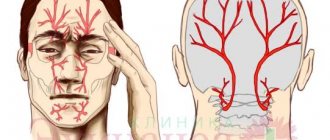Some people experience anxiety when thinking about the materialization of bad thoughts. This obsessive state harms the person, his normal work and life. “Help me cope with the fear of materialization of thoughts,” these are the words that come from the lips of people suffering from such a phobia.
The possibility of thoughts materializing can cause panic fear
It is important to provide timely support to such people, because fear can be so strong that it is difficult to cope with it on their own. You should learn to motivate yourself to constantly fight the phobia in order to restore normal human functioning.
Truth and lies about the materialization of thoughts
The human psyche is endowed with one important property - thinking. Without it, people would become inert. All life, as well as the conditions of existence, are all the result of human activity, for which the mind, with its effective ideas and plans, is responsible.
It is worth thinking about materialization as a real possibility of the human brain. Many adherents of psychology are confident that such a gift exists, but it is not yet open to modern people. Various psychics and parapsychologists think so.
Good thoughts that can be materialized are a true gift of humanity. These thoughts, like bad ones, can have an impact on the outside world. It’s up to everyone to believe it or not, but scientists have proven with simple examples that the inexplicable can become real.
The first example is the influence of the human voice on plant grains. During the experiment, they were irradiated with X-rays, divided into two parts and placed in front of two different people. One of them said out loud the words asking him to germinate the damaged grains. The other was uttering a bunch of meaningless words. The result of this study amazed the public. The man’s request came true, but the second part of the grains could not germinate.
The second example is related to water. This liquid has its own memory, which is sensitive to external information. Its structure changes depending on a person’s emotions.
Compulsive symptoms in OCD
People with OCD often use compulsive behaviors ( take an OCD test ) to control their obsessions. For example, an anxious patient checks the smell of his breath. Some actions are taken to relieve stress (although there are more effective methods), others are aimed at preventing a dangerous event. A compulsive action does not necessarily have a logical connection with an obsession. For example, a child may count steps to prevent the death of a parent. However, if actions and thoughts are related, the action will be very disproportionate to the risk.
Obsessive-compulsive behavior is frequently and excessively repeated. It almost always interferes with everyday life. Some people feel forced to spend hours on their compulsive needs. Others may go out of their way to avoid certain triggers. Many people with OCD know that their behavior is not “logical”, but they still feel anxious and confused until they complete the necessary “ritual”.
Psychological portrait of the patient
Obsessive thoughts can occur in both children and adults. The psychological portrait of the patient has its own characteristics. According to psychologists, most often such an individual:
- Experiences fear of thinking as a process itself. The patient experiences confusion from struggling with his own fears.
- He painfully experiences his own uncertainty and is afraid that what he previously imagined will come true.
- Critical of himself. The patient understands that he has mental problems and perceives this as his own shortcoming.
- Demanding of himself. Existing signs of a nervous disorder force the individual to begin searching for a way to combat the problem that has arisen, constantly comparing those around him to himself.
The nature of bad thoughts can be different. The patient can talk about violence and cruelty, his own actions, sexual perversions, etc. Whatever he thinks about, his problems affect his general mental state. Therefore, it is important to promptly get rid of fear, which interferes with the full development of the individual not only spiritually, but also physically.
Bad thoughts can have different themes
Compulsive behavior may include:
- Check: A person may get up several times a night to make sure the iron is turned off. May also reread each email or text a dozen times to check for typos.
- Cleaning: People with OCD can wash their hands until the skin cracks. They can also disinfect household items after each use (instead of following the instructions in the owner's manual).
- Repositioning/Repetition: A person may press a light switch a certain number of times or straighten clothing until it is perfectly straight.
- Withdrawal: A person may repeat the same phrase to “cleanse” themselves of sexual thoughts or unpleasant images.
When a person's obsessive feelings are not obvious to observers, they are said to have pure obsessive OCD (also called pure OCD). For example, a person may silently count to 100 after completing certain tasks to ensure that they end with a “safe” thought. Another, for example, may mentally recite strings of words to make sure he doesn't lose his memory. Compulsions can interfere with a person's functioning, even if they are not visible to others.
How to stop thinking about bad things
Help yourself or consult a psychologist. Most experts are confident that such a psychological disorder can be easily eliminated. The fact is that obsession is a problem that can be solved even without taking sedatives. You need to learn to control your own thinking and promptly “switch” thoughts from negative to positive.
Another problem is finding motivation. The constant struggle with bad thoughts often becomes the cause of fatigue, when the patient wants to give up and not continue his path to recovery.
At such moments, it is important to talk to yourself, ask yourself what recovery will bring, and evaluate the work that has already been done. In addition, it is easy to find mental relief in simple things such as:
- watching your favorite movie,
- listening to music,
- hobby,
- going to a cafe with friends or family.
Any activity that brings pleasure will help you continue to fight your own fear. Surround yourself with positively minded people, and only then will you become happy yourself, stopping thinking about the bad.
Gender and ethnic differences in OCD
Adult women tend to have higher rates of OCD than men. However, men are more likely to develop obsessions and compulsive behaviors during childhood. Women are more likely to have cleaning-related symptoms. Symptoms in men more often fall into the categories of symmetry or taboo. Men are also more likely to have comorbid disease than women.
The prevalence of OCD is similar across ethnic groups. Internationally, prevalence rates range from 0.3% (Brazil) to 2.7% (Hungary). The age of onset and the nature of symptoms are usually the same in different countries. However, the culture of a region may influence which topics are more common.
Exercises to combat fear
Psychologists advise patients with an obsessive fear of the materialization of their own thoughts to work on self-control. Special exercises can help with this. The most effective are:
- Burning. You need to write down disturbing thoughts on paper, then burn it, imagining how the fear itself is destroyed.
- Moving towards your own fear. One must master what one is afraid of. The path to recovery lies through the search for control of the condition using the method of forced adaptation. Along with attempts to master his fear, the patient gradually gets used to it.
- Recreating materialization. You need to artificially recreate any of your own anxious thoughts. The evoked emotions and reactions should be recorded in audio format, which the patient can later listen to, developing adaptive immunity to it.
- Self-digging. Dive into your own fears. It is important to find the essence of your critical condition, acting persistently and decisively, despite the anxiety that arises. You need to not turn away from your problem, but pay attention to it.
To find an effective way to combat anxiety, you need to understand its basic patterns. If the patient understands the specifics of his own fears, it will be easier for him to cope with them. Don't forget that you can always turn to specialists for help.
Burning your fears on paper will help you get rid of them.
Common causes
- Violation of the coherence of the cerebral cortex due to physiological changes in the body (age-related, hormonal changes)
- Impaired functioning of the senses or distorted perception of information coming from them (due to the use of chemicals, medications)
- Superstitions, mysticism, the feeling of being “pursued” by karma for sins committed
- External provoking factors (careless words of specialists, thoughtless reading of medical reference books and searching for information on the Internet)
- Rich imagination, increased level of empathy
Practice shows that fears often arise in people who, for some reason, forbid themselves to feel. After all, feelings make us open and vulnerable.
As you can see, the causes are quite varied.
The desire to be “not like everyone else” and the romanticization of disorders
To a large extent, the search for psychiatric disorders in oneself is facilitated by the general romanticization of mental disorders.
I can remember several cases from my practice. One day a girl came to me and suspected she had schizophrenia. She said so right from the door: “I have schizophrenia. I hear voices".
A detailed analysis of the situation revealed that she was a big fan of one popular mystical program. One of the characters in this program allegedly suffered from schizophrenia, but did not want to be treated because, thanks to his illness, he “heard the voices of the dead.”
The young girl really wanted to be like him, so she also began to interpret her ordinary everyday thoughts as “voices of the dead.”
The “patient” was treated as follows. She was described the procedures that she would undergo in the treatment of her fictitious illness, after which the “voices” immediately fell silent and did not bother her anymore.
A somewhat comical incident, isn't it? Unfortunately, there are also tragic stories on this topic, which I will not talk about, so as not to traumatize an overly impressionable reader.
Where does the fear of going crazy come from in people with neurosis (VSD)?
Vegetative-vascular dystonia is not a disease at all, but a mental disorder. Against this background, the entire neuro-vegetative system breaks down and the person receives a huge number of physical symptoms (psychosomatics), accompanied by panic attacks and constant anxiety.
An anxious mind gives rise to an endless stream of equally anxious thoughts, fears, and phobias. The interesting thing is that if a fighter thinks for a long time about the fear of going crazy, he may well cause a panic attack with these thoughts. Exactly the same as the other way around – an attack gives rise to thoughts of fear of “going crazy.” Such a vicious and endless circle.
A panic attack itself, no matter how it manifests itself, is a very disgusting, painful and difficult to control condition. There are so many symptoms, and they can be so varied, that you may think one day you won’t be able to cope with it all, you will simply not be able to stand it and “go crazy.” In this state, many are afraid of harming themselves, loved ones, and even accidentally committing suicide.
The fact that most people go the wrong way and begin to treat the symptoms of neurosis (VSD), and not its causes, results in few results. A person does not leave doctors’ offices, swallows pills, goes to MRI 3 times a week, but there is no improvement. You can find out which doctor you should see first here. Panic attacks continue, physical condition worsens, moral strength dries up. Here, anyone will probably think about the possibility of going crazy - after all, living like this is simply unbearable. It is also frightening that most people simply do not understand what is happening to them and why they feel so bad.
You should not be afraid of the very thoughts of madness; they are quite justified in such a state, and appear in many people suffering from neurosis. The question is, is it really possible to lose your sanity due to VSD? More on this below, but now a small piece of information to reassure you that similar phobias also occur in healthy people.
Learn self-regulation
How to get rid of increased anxiety? Psychologist and social educator Svetlana Troshina advises using such effective methods of self-regulation as:
- switching (“It will be tomorrow, but today I won’t think about it and read this book”);
- distraction (detachment from disturbing factors using willpower);
- reduction in significance (“This is just a report on the work done, the same as there have been many already”);
- thinking about an alternative plan in case of failure;
- making additional inquiries (if you need to find an unfamiliar address, find it on the map, look at the street visualization);
- temporarily deferring a goal to include new milestones (for example, take a skill development course to implement a new project).
Working with fears and anxiety never stops, since these feelings are natural for humans. It is important that they only occur in situations of real danger. That is why you should free yourself from excessive anxiety and enjoy life.
Original article: https://www.nur.kz/family/self-realization/1734404-kak-izbavitsa-ot-straha-i-nacat-zit/
What is a phobia
The fear of going crazy or committing an uncontrollable act is called lissophobia. Years earlier, this name meant the fear of being bitten by a fox, since the animals were carriers of rabies, and this, as is known, is a fatal disease.
People who are afraid of contracting rabies thoroughly study the problems and symptoms of the disease and constantly check themselves for its presence. Signs of foxophobia are fears of mammals and rodents. The person is so frightened that he avoids any physical contact with animals and is afraid of the ashes of dead animals. The patient thinks that through touch or smell he can become infected with rabies or some other diseases that animals carry.
Lyssophobe is capable of aggravating his own condition so much that he himself believes in what is happening and moves from studying the symptoms to practice: he can begin to imitate the disease, showing everyone his poor state of health.
Technique 4: Let go of control
And now we come to our favorite part. The techniques that I described above (except, perhaps, relaxation) have one serious drawback. Yes, they often work. But nevertheless, in their basic essence, at the deepest level, they sometimes seem to “feed” fear.
I don't want to say that they shouldn't be done. They just have limitations.
Let me try to explain what's going on.
Why are you even trying to prove to yourself that there is nothing wrong with you and that you are not going crazy?
Because you are still afraid of it. You are afraid of the worst-case scenario that comes into your mind, so you look for evidence that it will never happen, using common sense.
That is, the very desire to use the technique of affirmations and realistic attitudes comes from fear.
And since it comes from fear, then the final word very often remains with fear.
I'll show you with an example:
“I’m fine, I’m coping, people don’t go crazy from PA”
And your fear tells you:
“What if it’s not PA?” - and we went on a new one. Do you know what I mean?
Another problem is that when during an attack you try to find support in common sense, the part of your consciousness that is responsible for that very “common sense” during a panic attack is greatly suppressed. (The limbic system of the brain is activated, and the anterior cortex is suppressed)
Therefore, trying to go against fear, trying to refute it, is sometimes like trying to go against the wind on a ship:
Of course, you can get creative and position the bow of your ship so that it eventually reaches the shore against the wind. But it will be a very tiring voyage.
Therefore, my favorite way, which has helped me out more than once, is a way to relax and stop going against fear.
This method is good because it does not come from fear, but from a state of acceptance of what is happening to you!
What am I trying to say? Sometimes a way that works very well is when you stop convincing yourself that everything will be okay with you. When you just give yourself completely and completely to this fear. Accept everything that happens to you, letting go of any resistance:
“Let me go crazy, I don’t care!” “Let them take me to a mental hospital” “If this is destined to pass, so be it!”
Yes, you instinctively want to calm and encourage yourself. It's easier. And often it works. But the sure-fire way, even though it requires more training, is acceptance.
Because at this level of a panic attack there is nothing to parasitize on. Panic attacks are like parasites that cling to what is most valuable to you: health, sanity, loved ones, your life
And if you say that nothing is important to you at the moment, “come what may,” then in this case fear has nothing to cling to, nothing to scare you with, because you are ready for anything
And then fear falls silent, having lost its support.
But I repeat, if it is difficult for you to understand how to perform this technique. Or you tried it and it didn’t work, I remind you that not all at once. Techniques require practice. And if you do them regularly, then you will soon feel relief and confidence.
I remember how a day came in my life when I began to think like this: “come on, attack, come, I don’t care! I’m ready to meet you and reflect you!”
And soon the time came when the attacks left me.
But that only happened when I stopped wanting them to go away!
“Wait, Nikolai, what?”
Exclaim!
The attacks will go away when you stop wanting them to go away!










